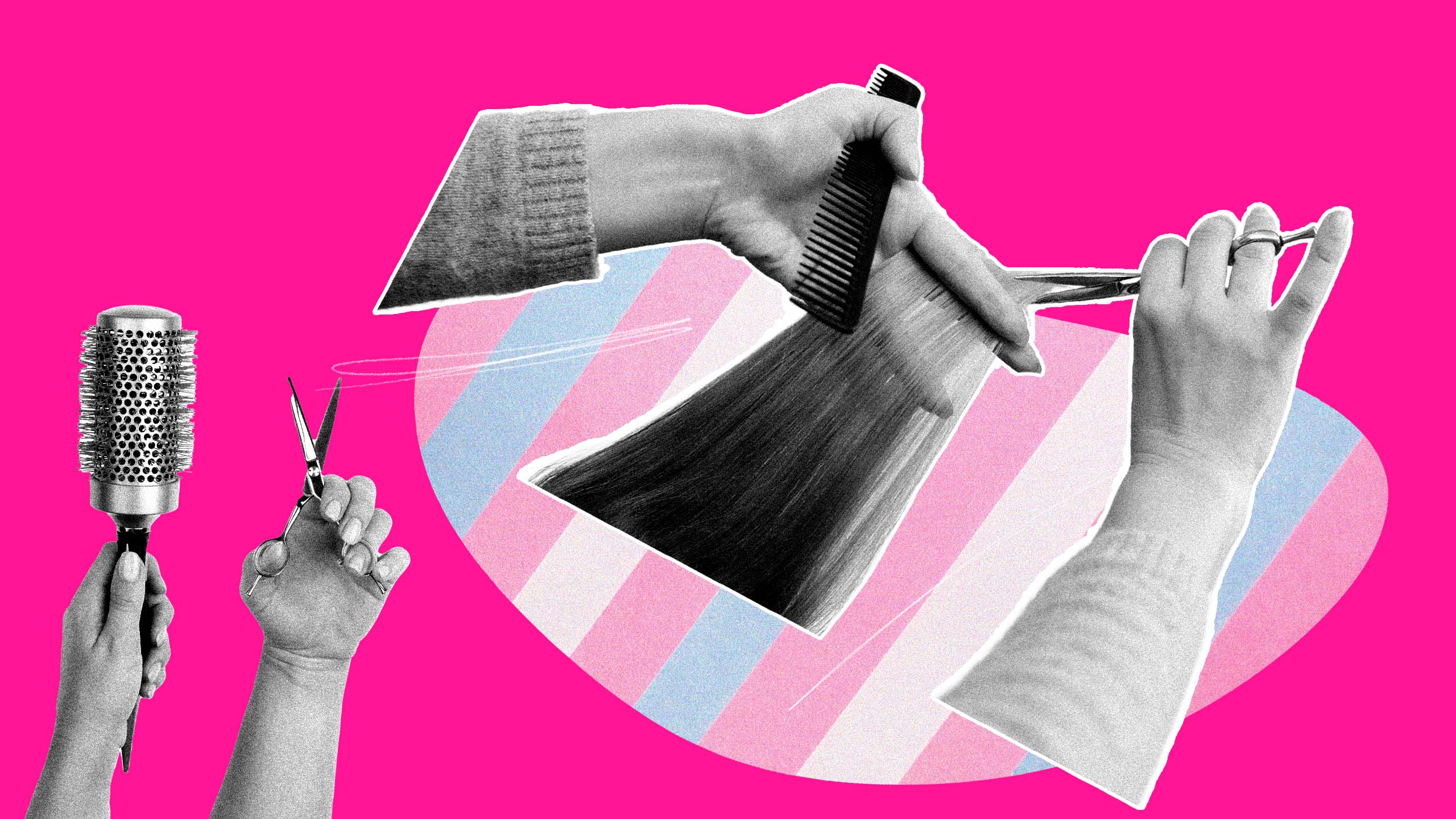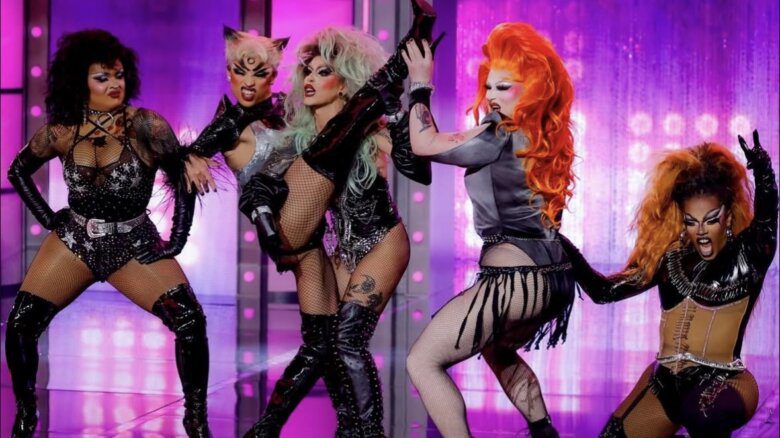Over the last few years, we have come to realize just how valuable the beauty services industry is to individuals in the LGBTQ2S+ community; the fact of which was recently highlighted, thanks in large part to the pandemic.
But prior to the pandemic, for many queers, hair has always been an outlet to express one’s true self. A part of their beauty routine that they could have full control over. But getting there meant having the support of inclusive barbers and hair salons in order to access that freedom.
With more individuals seeking out refuge from their day-to-day lives, which at points can be traumatizing, something as simple as a haircut–can provide a more financially accessible way (than most forms of self-care) to feel looked after, offer a quiet moment to chat with someone who understands them and, for once, time to relax and focus on themselves. For many individuals, a haircut is just a haircut. But for people in the LGBTQ2S+ community, it’s a form of healing and a big reason why gender-inclusive salons and barber shops are so vital.
Greg Robins, the executive director of BeautyCouncil, a membership organization that helps to develop standards for professionals in the salon, spa and barber profession through professional certifications, codes of practice, industry guidelines and accessible continued education, told The Squamish Chief in a September 2022 interview that he felt unsure if salons and barbershops that are geared toward specific genders had fully adjusted yet. Most salons have different prices—often gendered—and simply a lack of awareness when it comes to creating a space where those in the trans and non-binary community can feel safe and comfortable. According to a 2019 survey by Pantene, 93 percent of trans and non-binary people have been misgendered at a salon, and nearly a third feel stressed before every visit.
This is why organizations like Dresscode Project, Strands for Trans and Hair Has No Gender UK have started. These organizations helped individuals in the LGBTQ2S+ community find gender-affirming stylists and hair salons in their areas by offering directories and maps. In addition, both Dresscode Project and Hair Has No Gender UK are helping to close the gap in the lack of trans-inclusive barbershops and hair salons by offering training and support to help educate and empower hair stylists and barbers on inclusive language, sharing gender-diversity-awareness training and also providing recommendations on how to start charging simply based on the length of the client’s hair, rather than gender. To date, Strands for Trans does not offer any additional services, but JP Gomez, co-founder of Strands for Trans, told NBC News in a March 2022 interview that they were hoping to expand their offerings to offer more education noting, “The educational piece is very essential to this.… That’s our next evolution.”
Gomez believes that many salon owners want to be good allies to trans folks, but just need resources on how to accomplish that. “Now that we have all these salon owners being part of the network, we want to give them tools,” Gomez said.
Kristin Rankin is the head stylist and owner of the Toronto-based salon Fox and Jane. In 2017, Rankin launched Dresscode Project as they continued to witness a lot of gender discrepancies within the beauty industry, and felt it was time to start an educational platform and initiative for those in the LGBTQ2S+ community.
“I just thought this can’t really go on like this … the community that I love and the industry that I love … don’t see eye to eye and I don’t love that,” Rankin says.
When they first started, there wasn’t really a plan that Rankin had created for Dresscode Project, but one thing was for certain: they wanted to make a positive change in the industry. One of their first initiatives was to email several other salon owners in Toronto who were friends and colleagues and share their concerns. Rankin passionately wrote to them: “Hey, so this happened and you know, it’s really not okay. I know y’all are awesome, inclusive people but this is how our industry is being represented. Are you okay with that?” hoping that their peers would join in to help activate change with Dresscode Project. In the same email, Rankin’s first call to action was to ask their fellow salon owners to change their pricing to be more gender neutral.
“The first return email I got from that group message was from a salon owner in the west end [of Toronto] and she was just like, ‘Yeah!’ and it just felt really good to know that people were like, ‘Of course this makes sense.’”
Outside of the language used, or simple changes inside of a salon to help create a safe space, there is other work to be done around hiring practices, removing gender from service offerings including pricing, and offering branding/messaging that demonstrates LGBTQ2S+ inclusivity.
Rankin believes that the role organizations like Dresscode Project play in the hair community are huge. As Rankin splits their time between Toronto and Texas, they admit that they have started to have more conversations with those in their hair community in the United States about what individuals can expect since Roe v. Wade was overturned, or the shortfalls of the United States government.
“The conversations I’ve had with friends here, a lot of the hair stylists are just wondering what might be next and how we have to be able to keep this up,” Rankin says, adding, “while the Supreme Court and government are trying to block a lot of things when it comes to healthcare services, it would be really hard for them to legislate hair.” Rankin acknowledges just how much the trans community has been affected by all of this, and knows there is still so much that organizations like Dresscode Project could be doing either from an educational and advocacy standpoint in regard to fundraising.
All across North America, there has been a steady rise in anti-trans sentiments and harmful rhetoric on and offline, with more than 30 states in the U.S. introducing bills to curb the rights of trans people, erasing trans individuals and taking away their own bodily autonomy. There is still a long way to go when it comes to education in and out of the beauty industry. Rankin knows there is still so much to be done. “I just never put anything past hate, to be honest with you—hate and fear. They’re incredibly powerful emotions and tools. Put them in the wrong hands as they have been, and this is what can happen.”
Kate Jude (KJ) Spata is a 25-year-old non-binary and neurodivergent hairstylist who lives in Richmond, Virginia. They attended college for two years to study interpersonal communications and media, but eventually left in 2018 to focus on hair.
Spata explains, “Instagram is kind of like LinkedIn for the hair industry, and I used it to network,” adding that the inclusive hair industry was much smaller than it is now, making projects like Dresscode Project much easier to find, and acknowledging that the inclusive hair industry has gotten larger out of necessity. “There’s a large gap and a large portion of people who aren’t served in the way they should be.”
Currently, 15 percent of Spata’s current clientele are trans youth and neurodivergent individuals. Many queer individuals who seek out a stylist or barber want someone with whom they can feel confident and safe. Someone who they can speak candidly to, and who allows them to experiment in whatever way they need to in order to show society who they really are, and how they would like to present to the world. “You’re providing a certain level of care for people,” Spata explains, noting that it’s important to be very tender and continuously check in on clients to see how they are feeling.
Spata shares, “I had a trans kid for my last client recently. His mom would wait in the car, and it would just be us in the studio. So he really got the space to talk, and I really appreciated that the mom waited outside and let us talk and have our space. Because just this week, they were asking me about my top surgeon and I love being able to talk about her and recommend her.”
Right now, organizations like Dresscode Project and Strands for Trans are helping to close the gaps in the lack of education and awareness surrounding trans-inclusive hair salons and barbershops in the U.S and Canada. “A transformative, gender-affirming haircut is almost like your first step into realizing yourself as you might actually want to see yourself,” says Rankin. Often, as one is navigating their own gender journey, it requires the peeling back of many layers, and reaching deeper levels of self-reckoning, which only a hairdresser with lived experience can help you through.
Spata agrees, acknowledging how it can be a form of community care and saying that most clientele who walk through their doors tell them that they are the first hairdresser to give them the haircut they wanted, or openly understands their hair and also them.
Sevan Mujukian, is a non-binary Armenian-American adjunct professor, visual artist and musician based in L.A. After hearing about Strands for Trans, Mujukian started Googling and came across the network of trans-inclusive barbers on their site. “You know, in L.A., there are a ton of places where I could have gone. But I looked this one up, and it seemed appealing, comfortable to me—if that makes sense?”
Mujukian decided to forego their usual Armenian barbershop, with its cheap haircuts and a barber who cuts their mom’s hair (as well as theirs) to try a salon within their LGBTQ2S+ community.
“From the get-go, it was just a different experience,” Mujukian says. Besides the fact that the person cutting their hair identified as a non-binary person of colour, Mujukian felt a sense of comfort and ease sitting in the chair. “I didn’t know what to expect. But they had a cute little workstation set up with gender-affirming pins and it was such a different experience, but also way more expensive.”
Mujukian explains that in the past, one of the things that typically has held them back from booking into a trans-friendly salon is the cost. Normally when they have visited their Armenian barber, he would charge $20 for their cut. Mujukian shared that while the haircut itself at the salon they found via Strands for Trans took an hour—the longest cut they have ever had on their short, pixie-style hair—there was a level of intimacy about the whole visit they were not expecting. “I wasn’t being rushed at all. It wasn’t just get in and get out. This person was very gentle and took the time to explain everything to me, without making me having to overexplain myself.” However, Mujukian recognizes there is an element of privilege in this.
“Sure, I did get my hair cut at a trans-friendly salon, but I’m probably not going to do it again until I have way more money. You know, it speaks a lot to pay $50 to feel comfortable. That’s a pretty big privilege in itself,” Mujukian explains. The traditional salon pricing menu sets men’s cuts at a lower price than women’s cuts, but is it time to let go of this notion? The short answer is yes! Having salons and stylists base their service menu off of factors such as time, technique or length can be more convenient for booking, and help to widen your customer base. As others begin to realize just how much work and time goes into each cut, their pricing can match that.
As we know, hair is an external, vital element of queer identity and can make just about anyone feel comfortable in who they are. It takes courage, even risk, to allow your gender expression to be presented in your hair, which is why having a designated list of salons and beauty spaces for trans and non-binary individuals is so important. It takes away the difficulty of potentially gendered assumptions and ensures a welcoming, safe and inclusive environment. So, how do we convince the industry to make this standard practice, rather than just a few places adhering to this trend? Rankin says, “If every salon and every barbershop, you know, got it and changed their menus to reflect hair, not gender, their spaces would automatically be inclusive and accepting and welcoming. And honestly, that would be amazing. It would just be time well spent if we were able to do that and help change an industry that didn’t even realize it needed changing at first.”


 Why you can trust Xtra
Why you can trust Xtra


